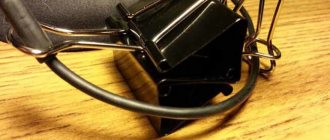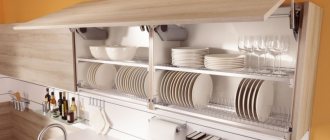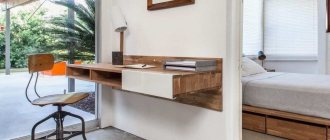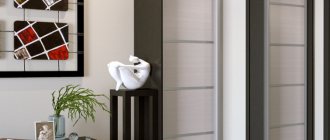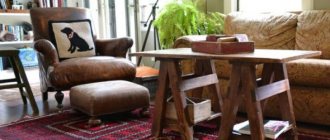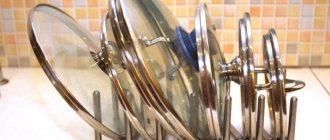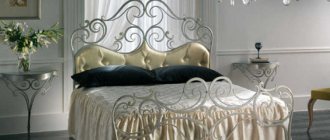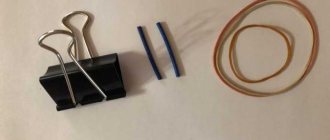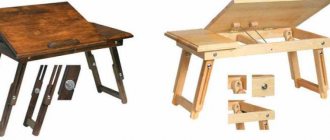Not a single kitchen is complete without knives, where you can find such tools of different sizes and different purposes. Everyone stores them differently: some store them in bulk in one place, while more careful users store them in different sections of their kitchen furniture. Another good way is to place knives in a special storage stand. You can buy it, or you can make it yourself. True, in this case you need to show artistic imagination and the ability to work with your own hands. In addition, you need to acquire certain materials and tools.
Knife stands PHOTO: tytmaster.ru
Knife holder with filling
The question arises - why do you need a stand? After all, you can do just fine without it. Firstly, it can be done beautifully. Secondly, it’s convenient: all the knives are in front of your eyes, you can immediately select the one you need. And thirdly, safety - the blades are hidden in the stand, only the handles stick out from above.
There are countless options for stands. Everything is determined by the purpose of its creation, the imagination of the author, the availability of material and the skill of the craftsman.
The design of any stand requires the presence of a body or base and a device for holding the knives themselves. Cases can be made of wood, plywood, metal, paper, plastic, glass. You can hold the knife with a clamp, a slot, a filler, or a magnet. All these methods can be combined with each other.
Case manufacturing
You can make the body yourself, or you can find something suitable at home - a beautiful box, a glass vase, a piece of plastic pipe, and the like.
An interesting option comes from a beautiful bottle. Only you need to cut off the top part with the neck. This is done quite simply. You need to take a thin string, moisten it in alcohol, wrap it tightly and neatly around the bottle in the right place and set it on fire. While the string is burning, the bottle must be held horizontally and slowly rotated so that the flame heats the entire circumference. When the thread burns out, the bottle must be lowered into a previously prepared container with cold water. At this point the glass will burst and the bottle will fall into two parts. The one with the bottom is the body for the stand. Sharp edges must be carefully filed down and rounded with an emery stone or rough sandpaper.
You can make the body from trimming a PVC plumbing pipe of a suitable diameter. A piece of the required length is cut from it, and the bottom is attached at one end.
Option of a wooden case for the stand PHOTO: tytmaster.ru
Types of fillers
To prevent the knives from dangling in a beautiful box, you need to secure them somehow. There is a very good way: you need to fill the box with something, creating in it such an environment (filler) into which you can stick a knife, and at the same time, it will be clearly fixed in place.
Fillers come in bulk and from sticks. Bulk is any cereal poured into a box. By the way, this filler absorbs water well from just washed knives. When inserted into such an environment, the knife will not become dull, and it will stand firmly.
If the body is transparent, then you can take cereals of different colors and sizes - spaghetti, dried beans, peas, rice, buckwheat, pearl barley - and pour them into the container in layers of different thicknesses.
Another option is stick filler. These can be ordinary thin slats, wooden skewers of different thicknesses, bamboo strands from napkins or curtains, etc. Plastic broom bristles are good for this purpose. You can use plastic cocktail straws. The main thing is that their length matches the height of the box, and their number should tightly fill this box.
Coasters with multi-colored filling PHOTO: tytmaster.ru
Knives of various shapes and even scissors can be inserted into such filled stands.
Book pages are a kind of filler. If you fold and tie a stack of old books tightly, you can stick knives between their pages, and they will stay there well. The main advantage is that you don’t have to spend a long time looking for material, and the manufacturing time is minimal. The disadvantage of this option is its fragility.
Book stand PHOTO: tytmaster.ru
If the style is more suitable for wooden kitchen accessories, the container can be made from scrap boards and filled with bamboo sticks.
DIY wooden knife stand
If you decide to make the stand yourself, the easiest way is to make a wooden box. It should be no less in height than the longest knife that will be in it. The bottom can be made as desired.
The necessary tools are the most common: a hacksaw for wood, a small plane, a drill (can also be hand-held), screwdrivers, a hammer, pliers, a glue gun, a ruler or a square.
To make a simple wooden case, you first need to draw at least a sketch of it with dimensions. For work, it is better to choose already sanded boards of a suitable size. You can, of course, trim and process them yourself, but this is a more labor-intensive process that requires special skills. Having taken these four planed boards, it is worth solving the most important question in this matter: how to connect them to make a product. You can simply glue it “into an overlay”, you can knock it down with nails or screw it with small screws. Curly heads will look good. A skilled carpenter will assemble the structure into a tenon. If you decide to glue, then there is a wide choice of wood glues, for example, PVA. The finished product should be rubbed with oil or clear varnish to reveal the wood structure. You can decorate the body endlessly, the main thing is not to lose your sense of proportion.
It is not advisable to make a solid bottom, as water and dirt will accumulate. It is better to drill holes or attach a grille made of material that is not subject to corrosion.
The most numerous and varied knife stands have special narrow grooves in their design into which the blade is inserted. Only the handle remains visible. You can also make them yourself, using methods of gluing or screwing individual parts. On top of the wooden box you can attach a plate with holes into which the knives will be inserted.
Wooden stand with filler PHOTO: tytmaster.ru
Tabletop with legs
A variant of an unusual design can be considered a stand, which has four small legs attached underneath the bottom.
Wall-mounted shelf
These are two plates assembled at right angles. The vertical plate is mounted on the wall. You can install and secure a regular container with filler on the horizontal one. Or cut holes in it and stick knives in there. Or install a sculpture.
Stand in the form of a shelf with a figurine of a man PHOTO: tytmaster.ru
Types of knife stands
As already mentioned, manufacturers make stands from various materials and various shapes. How much imagination do the designers have? The direct purpose of knife holders is clear from the name, and their place in the kitchen. Let's look at a few popular products:
Sectional box
A good option for those who prefer the unusual to the ordinary. The advantage of this method is that it is organized in a drawer into which a sectional block is inserted, allowing you to store not only a large number of knives, but also other kitchen utensils. Volume, size, material and style can be selected according to your preferences.
Wooden shelf
The device looks pretty simple. A hewn board with sawn holes for knife blades and varnished. The design has special hangers for the headset. Convenience and safety and products are quite acceptable:
- the blades of the knives do not touch each other;
- knife handles are freely accessible;
- the cutters sit securely in the holes;
- The height of the drawer mounting will prevent children from accessing the knives.
It is easy to mount a hanging shelf to a cabinet cabinet.
The only drawback is that the blades must be thoroughly wiped before storage. Otherwise, moisture will collect at the bottom of the box. Which will negatively affect the product itself and the knives, which can lead to the appearance of rye.
Vertical wooden stand
This option is suitable for saving space in the kitchen. Wooden racks are sometimes made from combined materials. Adding to the wooden base: plexiglass or metal. The principle of operation is the same as the previous version, but only the product is in a vertical position.
Its advantages are as follows:
- knife blades do not contact each other;
- considerable space saving;
- possibility of moving the structure.
The disadvantages of the design include the following points:
- when removing the knife, the cutting edge touches the wooden surface;
- accessibility for children;
- accumulation of moisture in the cells.
The section on making a knife stand with your own hands describes the process of self-assembly. The product is not for everyone, but it is quite functional.
Slots in the table top
This option is used at the planning stage of kitchen design. Slots in the tabletop save a lot of external space. But inside the cabinet, a separate box should be mounted, the blades of the knives are lowered there. For convenience, the slots are made near the wall - this is an indispensable advantage.
It is difficult for children to reach the products. The disadvantages are the same as their predecessors - you will have to wipe the knives dry. Moisture will damage both the countertop and the cutters.
Original figures
Products of this type are made to order or independently; you can probably find them in a gift shop. They are made from wood in the shape of the human head of famous movie or cartoon characters.
Quite an interesting example in the urban style of the comic book anti-hero – Deadpool. The wooden blank is covered with film of the required format. It is ordered from printing workshops.
Then the film is trimmed in the required places, and slots are made for the blades. The accumulation of moisture in the holes is a huge disadvantage of the product. This stand is more suitable as a gift in a decorative style.
Stand for knife collection
There is no need to buy sophisticated options, the main attribute will be knives, all attention is on them. The stand for a small collection looks simple and is made of wood. The most delicate material for exhibits. Often they are assembled by hand by craftsmen. With unique blades, the exhibition looks great.
How to make a knife stand with your own hands from plywood
The design consists of a plywood plane on which nests for placing knives are formed by horizontal and vertical slats. You can use a suitable size plywood cutting board. In addition, you need to take three wide slats and attach them horizontally to the base. You will also need several thin blanks, the thickness of which should be slightly greater than the thickness of the knife blades. And the number of formed channels is equal to the number of knives.
Stand for knives made of plywood PHOTO: mebel-expert.info
Materials and tools
When working with wood, the set of materials and tools remains constant. Usually this is a plane, a set of fasteners, sandpaper, and in some cases you can use wood glue.
An interesting version of a knife stand in the shape of a person
Funny design solutions are obtained if the holder is made in the form of a sculpture, for example, of a person. The figure itself must be cut out of plywood with a jigsaw. If possible, use a laser programmable machine.
Usually the most difficult thing in making is coming up with an interesting sketch.
Stand in the shape of a person PHOTO: mebel-expert.info
What materials will be used to make the stand?
From the photo of a self-made knife stand you can see that it is mainly made of wood, since this is the most common material.
You can make a wooden knife stand with your own hands in this way:
- Decide on the size of the stand and find a suitable size board.
- Clean it up.
- Glue slats on the sides that are thicker than the board itself.
- Decide on the location of each knife.
- Place slats between the knives and glue them.
- Glue slats perpendicular to the top, which are thicker than the previous ones.
- If desired, use paints and other design ideas.
A stand for kitchen knives can also be made from wooden blocks, between which there will be squares for connecting the bars to each other and for partitions.
In large bars it is necessary to cut grooves that will serve for inserting the bars. The entire structure also needs to be sanded and then assembled.
«>
You can also invent a stand for knives from a wooden board and magnets.
Lubricate neodymium magnets with glue and insert them into a small groove on the board itself. It is necessary to attach fastenings to the stand, thanks to which it can be fixed to the wall.
These are the simplest ways to make a knife stand with your own hands. There are also more original ways of making such stands, which are distinguished by the irrepressible imagination of designers and a lot of unexpected accessories.
The base of the stands can be a glass, plastic, iron can, or various containers.
DIY magnetic knife stand
This device is not actually a stand, but a device for conveniently assembling knives in one place, consisting of a bar on which magnets are attached. The knives are held on them. The model has many advantages over other designs. It is hygienic, takes up little space, and you can attach any metal objects with magnetic properties to it.
It is very easy to make. Take a wooden plank and select a groove on the reverse side with a depth equal to the thickness of the magnets. The magnets themselves are glued into this groove in 3 cm increments. The bar with magnets is attached to the kitchen wall. That's it, the holder is ready.
To improve the appearance, the plank can be coated with colored varnish.
Materials and tools
The plank can be made from any available wood. It is advisable to use neodymium magnets.
Manufacturing instructions
For a person who knows how to use simple tools, the work will not be difficult. Plane the board, select a groove, glue in magnets. That's all the work.
The most traditional material
Most knife stands are made of wood. It can be a board, a platband, etc. To make a stand from a board, you will need special equipment, at least a jigsaw. Of course, not everyone can use such a tool, but there are still craftsmen. It is for them that we will consider making several stands from this material.
Materials and tools:
- wooden plank;
- thin and medium-thick slats;
- glue.
Take a board equal in length and width to the future stand. Clean it if necessary. Glue two thin slats on the sides. Moreover, their thickness should be slightly greater than the thickness of the largest knife. Attach the knives to the workpiece as they will stand in the finished stand, and lay slats between them.
When the distances are outlined, glue the slats. Next, glue the slats a little thicker perpendicular to the previous ones - top, bottom and middle.
You can use screws instead of glue. If desired, decorate.
Materials:
- 6 short rectangular blocks;
- 2 long bars;
- block of arbitrary length;
- 2 thick bars.
Make 10 squares from a block of any size; they will connect the blocks and serve as partitions. 2 pcs. glue them between two blocks, while simultaneously adjusting the width of the slot to the size of the knives. If necessary, glue additional squares into the middle of the slot for small knives.
Related article: Popular women's coat models: sewing patterns
In large bars, cut grooves to the size of the long bars (planks).
All parts should be carefully treated with sandpaper. You can cut off pieces of vertical strips for a more harmonious look.
Put the pieces together.
You can make a stand from a wooden plank and magnets. To do this, make a shallow groove on the board, lubricate it with glue, and insert several neodymium magnets into it. Hang the stand on the wall using fasteners.
Materials:
- wooden plank;
- insulating tape;
- glue.
Cut 8 identical parts (this is required for 7 knives).
Cut out 2 curved parts - side ones.
On each of the 8 parts, make an even notch with a width that is 3-4 mm larger than the blade of the largest knife. Assemble the parts, all grooves must match.
Seal the grooves on all parts with electrical tape and coat the edges with glue. Remove the electrical tape and glue the parts together. Make sure no glue gets into the grooves.
Clean the surface of the workpiece. Cut out a handle-holder for scissors. Attach it to the workpiece with a screwdriver.
Open with varnish. You can decorate using decoupage technique or paint.
A few more ideas in the photo:
Making homemade stands for other tools
At home there are a lot of things that would be nice to keep in order and accessible.
Scissor stand
Every home has scissors of different sizes. They usually lie around anywhere. They are also convenient to insert into a container with filler.
Knife sharpening stand
When sharpening knives, it is important to strictly maintain the required angle between the sharpening stone and the plane of the knife. And this angle is determined based on the purpose of the tool.
Straight razors are sharpened to 8-12º, fillet knives are sharpened almost as sharply - 10-15º. For common products in the kitchen, tools with a sharpening angle of 15-20º are used.
This implies a requirement for the design of a device for sharpening knives - it must be possible to set the required processing angle.
This is the solution. The knife is rigidly fixed in a horizontal or vertical position. The sharpening stone is fixed in a cassette, which moves along a special guide that forms a specified angle with the plane of the blade. The entire structure is assembled on a solid base that can be mounted on a table. At the beginning of the sharpening process, a coarse-grained stone is used, then the abrasive grain size is reduced. Instead of a stone, you can use a wooden block on which sandpaper is glued.
Homemade simple sharpening machine PHOTO: youtube.com
Ideas for making decorative knife stands with photo examples
Decorative stands reflect the individuality and artistic imagination of the author.
Kitchen
The themes of kitchen stands are varied - there is humor, images of plants and animals, and professional specifics.
Option for a stand for kitchen knives PHOTO: mebel-expert.info
Hunting
The decoration of stands for hunting knives is focused on the owner’s occupation.
Stand option for hunting knives PHOTO: mebel-expert.info

